The gut-brain axis is of crucial importance for controlling glucose homeostasis. Alteration of this axis promotes the type 2 diabetes (T2D) phenotype (hyperglycaemia, insulin resistance).
Recently, a new concept has emerged to demonstrate the crucial role of the enteric nervous system in the control of glycaemia via the hypothalamus. In diabetic patients and mice, modification of enteric neurons activity in the proximal part of the intestine generates a duodenal hyper-contractility that generates an aberrant message from the gut to the brain. In turn, the hypothalamus sends an aberrant efferent message that provokes a state of insulin resistance, which is characteristic of a T2D state.
Targeting the enteric nervous system of the duodenum is now recognized as an innovative strategy for the treatment of diabetes
By acting in the intestine, bioactive gut molecules that we call “enterosynes” can modulate the function of a specific type of neurons of the enteric nervous system to decrease the contraction of intestinal smooth muscle cells. Here, we focus on the origins of enterosynes (hormones, neurotransmitters, nutrients, microbiota, and immune factors), which could be considered therapeutic factors, and we describe their modes of action on enteric neurons. This unsuspected action of enterosynes is proposed for the treatment of T2D, but it could be applied for other therapeutic solutions that implicate communication between the gut and brain.
Source : Knauf C, Abot A, Wemelle E, Cani PD. Targeting the Enteric Nervous System to Treat Metabolic Disorders? “Enterosynes” as Therapeutic Gut Factors. Neuroendocrinology. 2020;110(1-2):139-146. doi: 10.1159/000500602. Epub 2019 Jul 2. PMID: 31280267.

